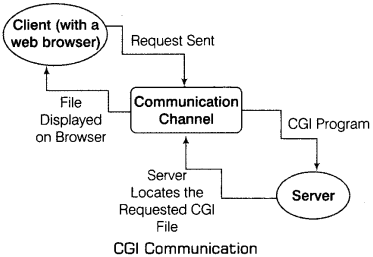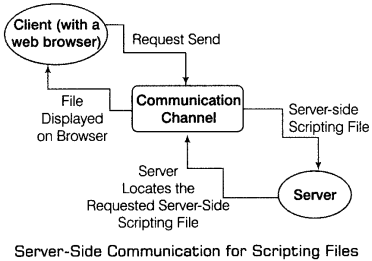Informatics Practices Class 12 Important Questions Chapter 8 Web Application Development is part of Informatics Practices Class 12 Important Questions. Here we have given Informatics Practices Class 12 Important Questions Chapter 8 Web Application Development.
Informatics Practices Class 12 Important Questions Chapter 8 Web Application Development
1 Mark Questions
Question 1.
Explain full form of the following terms:
(i) FTP
(ii) HTTP
(iii) SMTP
(iv) TCP/IP.
Answer:
(i) File Transfer Protocol
(ii) HyperText Transfer Protocol
(iii) Simple Mail Transfer Protocol
(iv) Transfer Control Protocol/Internet Protocol
Question 2.
Write the basic syntax of a URL.
Answer:
<protocol > ://< hostname>. <domain
name>. <domaintype>. <directory
name>/<file_name>
Question 3.
Differentiate between a web browser and a web server.
Answer:
Web Browser A web browser is an application software used to search something on Internet. Web Server A web server is like a connection, which provides the information requested by a client through web browser.
Question 4.
Why we use FTP protocol? (HOTS)
Answer:
FTP stands for File Transfer Protocol. It is used to transfer fi le between client and server over Internet. It is used to upload download the files from/to the Internet.
Question 5.
In the URL,
http://www.Mypic.com/index.html, what is the http component?
Answer:
http is a protocol used to define the format, transmission of web pages and action performed by web server in response to useras request.
Question 6.
In the URL,
http://www.Mycrop.com/pr/master.htm,
what is the/pr/master.htm component?
Answer:

Question 7.
In the URL,
http://www.Mymovie.eom/vr./index.html,
what is the www.Mymovie.com component?
Answer:

2 Marks Questions
Question 8.
What do you mean by a client and a server?
Answer:
Client Any computer process that requests some services from the web server is known as a client. Server Any computer process that provides requested services to an appropriate client is known as a server.
Question 9.
Discuss the use of protocols in networking.
Answer:
Protocols are the set of rules and regulations used to access Internet and to maintain communication between a client and a server.
Question 10.
Explain the role of a web browser in HTTP communication. (HOTS)
Answer:
Web browser is application software, which access information over the Internet. It is used for retrieving, presenting and traversing different data files on www. It helps a user to show the actions performed by the web server in response to user’s request.
Question 11.
What is Mozilla Firefox?
Answer:
Mozilla Firefox is a web browser used to access information over the Internet.
| Static Web Page | Dynamic Web Page |
| The content of this web page cannot be changed on web browser. It is easy and cheap to develop. It has some restricted functionality. It is developed by using HTML, XML, CSS, etc. |
The content of this web page can be changed on web browser by sending request to server and getting responses. It is not easy to develop and more expensive. It has much more functionality. It is developed by using the HTML, XML, CSS and any suitable programming language that is supported by Internet. |
Question 12.
Differentiate between static and dynamic web pages.
Answer:
Difference between static web page and dynamic web page:
4 or 5 Marks Questions
Question 13.
What do you mean by communication channel?
Answer:
Communication channel is a medium through which a client and a server communicate with each other. It controls and transmits the data between them. A communication channel acts as an interface between a client and a server. It may be wired or wireless.

Question 14.
Define WWW.
Answer:
WWW (World Wide Web)
It is a wide network of Internet that supports different web protocols.
World Wide Web is a common example of information protocol/service that can be used to send and receive information over the Internet (between clients and servers).
- Multimedia Information It includes different types of movies, music, pictures, graphics, sounds, text, etc.
- HyperText Information It includes the links of different types of information resources.
- Graphical User Interface (GUI) A user can point/click on the graphical icon to request any information instead of typing in text commands.
Worldwide web is based on client/server software design. A client/server software design requires two types of software to work in a communication environment.
Client Software It is a type of software, which is used by a client (or a user) to request some information from web server, e.g. Web browsers.
Server Software It is a type of software, which is used by the server to answer the request and provide the required information, E.g., Microsoft, Oracle, etc. It is possible to use your local computer as a server but usually, you want to have a fixed server, which runs 24 x 7 hours. So, more advanced and large systems are used as a server instead of local computers.
Question 15.
Differentiate between absolute and relative URL.
Answer:
(i) Absolute URL It is the type of URL, which uses the complete web path of a file to provide the location of the resource, i.e. they provide the actual domain name.
E.g., “http://www.oracle.sun.com/en/index.html”
(ii) Relative URL It is the type of URL that defines the path of an URL on a domain, without including the domain name. Relative URLs are more convenient because they are short in length, more portable in website maintenance.
E.g., we specified only “…/images/house.png”
Question 16.
Explain the two technologies used to generate dynamic web pages.
Answer:
For Dynamic Web Pages The client requests for a web page (DHTML file) from server via server-side software tools. The server locates the requested file in its database and passes it to the client, which is displayed on the client’s screen. A dynamic web page displays different content each time it is viewed. A dynamic web page contains client-side scripting or server-side scripting language to generate the changing content.
Dynamic web pages are generated by two different technologies as follows:
→ CGI Scripts CGI stands for Common Gateway Interface. It is the technique used to generate dynamic content on DHTML web pages according to the query passed through CGI program.

→ Server-Side Scripts It is the technology by which a user’s request is fulfilled through running a script directly on the web server to generate dynamic web pages. Some server-side scripting languages are ASP (Active Server Pages), ANSI C scripts, JSP (Java Server Pages), PHP (Hypertext Preprocessor/Personal Home Pages), etc.

Question 17.
What do you mean by user interface?
Answer:
User Interface It is the visual part of computer application or operating system through which a user interacts with a computer or a software.
There are mainly two types of user interfaces as follows:
- Command Line Interface (CLI)
- Graphical User Interface (GUI).
We hope the Informatics Practices Class 12 Important Questions Chapter 8 Web Application Development help you. If you have any query regarding Informatics Practices Class 12 Important Questions Chapter 8 Web Application Development, drop a comment below and we will get back to you at the earliest.